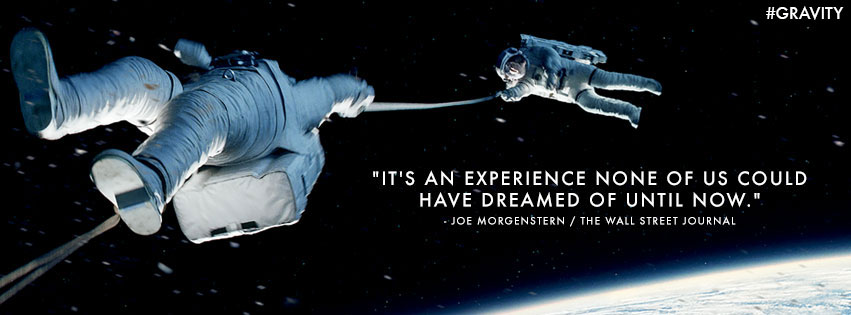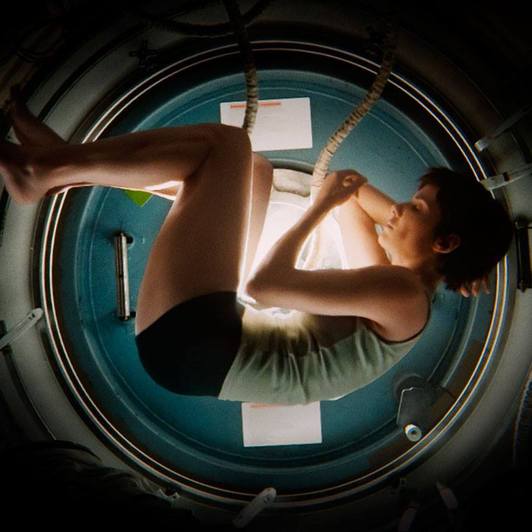The Visuals
Without a doubt, the first thing that will strike you and leave you in awe about this film is the ground breaking visual effects. The effects are so complex that Cuarón could not create the film when he originally wanted several years earlier, simply because the current technology did not meet his vision. However, in 2009, with the release of James Cameron’s Avatar, he realized he could now create the film and fulfill his high expectations (IMDB).
Since the beginning of production, Cuarón strongly desired everything to look as authentic as possible. One of the most important areas was the physics. As we all know, there’s no gravity in space. A moving object will continue to move unless acted on by a force. As a result, astronauts move, accelerate, and bounce off objects in unique ways. The daunting task was making sure each of these interactions look and feel as real as possible. Cuarón noted, "It took a lot of education for the animators to fully grasp that the usual laws of cause and effect don’t apply. In outer space, there is no up; there is no down." Ultimately, to achieve this level of authenticity, Cuarón and his team spent over two years pre-visualizing the entire film, shot-for-shot, carefully blocking and timing the shots. Only after this lengthy process was completed did they bring Bullock and Clooney on set (Brody).
This, however, was just one of the major areas the production team had to consider and carefully plan out. Another major area was the lighting. As we all know, light in space comes from the sun. The light rays bounce off everything in their path (Ex: Earth). In this film, however, with the destruction of a crew’s shuttle and our main characters whirling in every direction imaginable, the light reflection will rapidly change (Brody). Ultimately, the actors' facial light has to line up with the sun, earth, and star light. So how does someone change the various possible reflections that will occur? The cinematographer of the film, Emmanuel Lubezki, came up with the solution by inventing a new technology---a “Light Box” (IMDB). The box consisted of 196 panels, each containing 4,096 LED lights. An actor was placed inside the box, and, with computer software, the visual effects team could instantaneously change any LED light to form the correct reflection on the actor's face, costume, and props. As an added bonus, the box could display to the actor the scene they were supposed to be acting in (Brody). The end result of using the light box was only the actor’s faces being real photography---literally everything else in the space environment in the film was Computer Generated Imagery (CGI). As you can see, the visual effects team worked tirelessly to create the final, beautiful product you see in the film. Deservingly so, in this area, the film was nominated Oscars for Best Cinematography and Best Visual Effects.
The Direction
Besides the outstanding visual effects, another area the film excels in is masterful directing from Alfonso Cuarón. Cuarón, a Mexican-born director, is known for his long shots. It’s a trademark he’s used in his last couple films, including his last feature film, Children of Men. Gravity is no exception. Right out of the gate, the film opens with an almost 13 minute opening shot. Yes 13 minutes of one shot…something unheard of in the traditional Hollywood standard. I believe these long shots are utilized especially well in a film set in space, as the camera seems to be “floating” along with the astronauts. Brody notes, “These [long shots] transform audiences from observers to participants in the scenes, living in the tempos of these movies.” Furthermore, since the setting is the endless realm of space, Cuarón expands the use of the long shot by having the “camera, actor, and scene rotate and roll around one another in apparently complete dimensional freedom. This instantly communicates the feeling of true space operations” (Brody). Long shots, of course, added to the complexity of the film, as every scene had to be carefully planned out and perfectly executed, since it's one take. This was another one of the major challenges for production of the film. Besides the extensive use of long shots, there are also several very interesting POV (Point-of-View) shots, including some shots of the camera being inside Stone's helmet. The audience sees exactly what she's seeing, as well as hears her panting breath and low-oxygen indicators beeping. This is another way Cuarón makes the audience not watch the film, but experience it.
The Score
Another major technical aspect that this film excels in is the score. Composed by newcomer Steven Price (only his third feature film), the score succeeds in every way, conveying how space is vast and beautiful, yet brutal. Early on, Cuarón made it clear that the setting was space---a vacuum. There’s no sound. He asked Price to only allow sounds that the astronauts would hear. So how does one go about composing music for the film? Price stated, “I was asked to try and tonally represent things that would ordinarily be sound. You don’t hear an explosion in the film, but you might hear some pulsation in the music that reflects it. The score is doing the job of traditional sound, while the sound crew was able to do an interesting job on their own” (Rosen). For his work, Price received an Oscar nomination for Best Original Score.
The Acting
It’s obvious the film is a technical achievement. However, the film still could not have succeeded as well as it did without a strong performance from the lead actress….and Sandra Bullock delivered. Personally, I haven’t seen many of Bullock’s films. I can’t speak for how well she has acted in other roles. But I can speak for her performance in Gravity. Her character, Dr. Ryan Stone, is a depressed, lonely woman who, although she’s physically alive, really isn’t living. She lost her four-year old daughter in a freak accident. Since then, she has essentially stopped living life. She states to Kowalski early on that every day she gets in her car and just “drives”. When asked by Kowalski what she loves about space, she replies, “the silence”. However, when she gets stranded in space, she is left to ponder her situation and to think about moving on with life. She is repeatedly encouraged by the the always-optimistic Kowalski to not "let go" of life (thus the film's tagline)---to make the most of the time we have been given and to live life to the fullest. She goes on an emotional roller coaster in the film, and Bullock provides the powerful performance necessary for an emotionally distraught character like Stone. Bullock prepared months for the role, and in the end fully immersed herself in her character. She even used the new technology, the "light box", to her advantage. Since the box could only hold one actor at a time, it left her isolated from everyone, mirroring her character's dilemma. Bullock stated, "There was no human connection, other than the voices coming through my little earwig, which helped because it made me feel so alone" (Brody). Many people are calling Bullock's acting in the film “the performance of her career” and the film that will define her as actress. In any case, she received an Oscar nomination for “Best Performance by an Actress in a Leading Role”.
In conclusion, Alfonso Cuarón’s Gravity is truly a cinematic masterpiece in almost every aspect. It is without a doubt a technical achievement, embracing new technology and seriously raising the stakes for future special effects films. I think Richard Corliss of TIME summed it up perfectly: "Gravity shows us the glory of cinema's future." The film also showcases one of the most powerful forces on the planet---the human will to live. The motion picture has received tremendous critical and audience acclaim, and has received 10 Oscar nominations. In my opinion, it lives up to the hype. I saw it several times in theaters, including IMAX 3D, and thoroughly enjoyed it. Due to its tremendous success at the box office (grossing $700 million worldwide), Warner Bros. has re-released it in theaters (ComingSoon). On January 31, it will be re-released in IMAX 3D. If you haven’t seen this film yet, I strongly recommend it, especially in IMAX 3D, as this truly gives you the full, immersive experience.
Written by Anthony Watkins
WORKS CITED
Brody, Dave. “Making ‘Gravity’: How Filmmaker Alfonso Cuarón Created ‘Weightlessness’ Without Spaceflight.” Space.com. 03 Oct. 2013. 22 Jan. 2014. <http://www.space.com/23073-gravity-movie-weightlessness-alfonso-Cuarón.html>.
“Gravity to be Re-Released in IMAX 3D Theaters on January 31.” Coming Soon. 16 Jan 2014. 22 Jan. 2014. <http://www.comingsoon.net/news/movienews.php?id=113634>.
IMDB. 2014. 01 Jan. 2014. <http://www.imdb.com>.
Rosen, Christopher. “’Gravity’ Composer Steven Price On The Film’s Incredible Soundtrack.” Huffington Post. 04 Oct. 2013. 22 Jan. 2014. <http://www.huffingtonpost.com/2013/10/04/gravity-steven-price_n_4039455.html>.



 RSS Feed
RSS Feed
